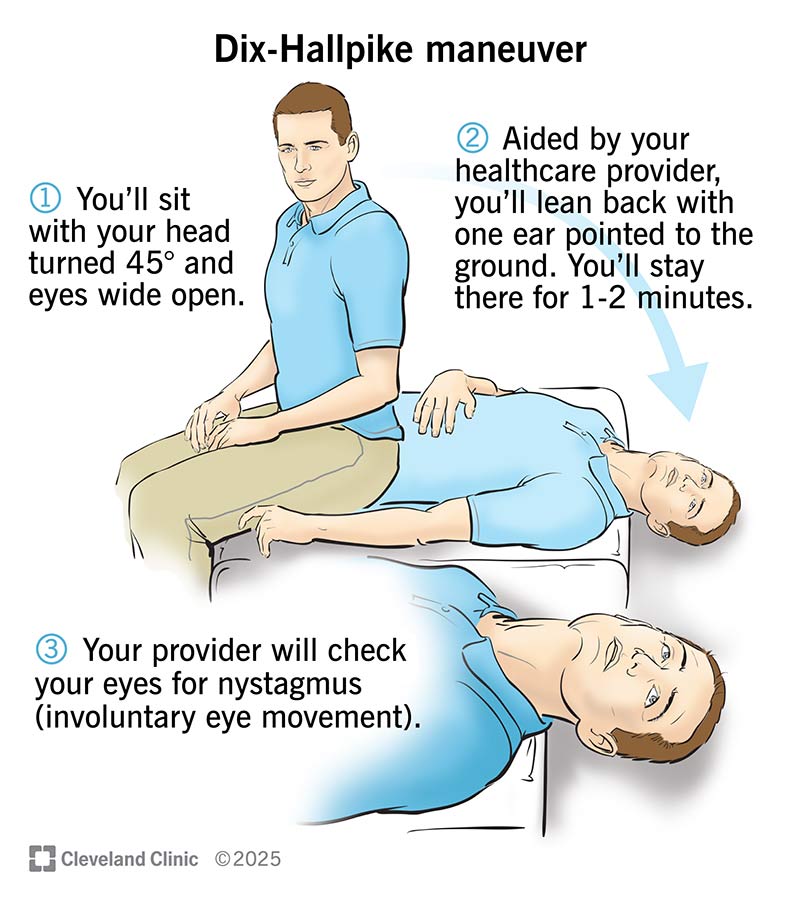The Dix-Hallpike maneuver is a test that healthcare providers use to diagnose BPPV — a common type of vertigo. During the test, your provider will guide you from sitting to lying down while positioning your head to the left or right. Then, they’ll look for involuntary movements of your eyes called nystagmus. Nystagmus means you have BPPV.
Advertisement
Cleveland Clinic is a non-profit academic medical center. Advertising on our site helps support our mission. We do not endorse non-Cleveland Clinic products or services. Policy

The Dix-Hallpike maneuver is a test used to diagnose benign paroxysmal positional vertigo (BPPV). Since 1952, the Dix-Hallpike Maneuver has been the gold standard test for diagnosing BPPV.
Advertisement
Cleveland Clinic is a non-profit academic medical center. Advertising on our site helps support our mission. We do not endorse non-Cleveland Clinic products or services. Policy
With BPPV, moving your head into certain positions may cause a sudden spinning sensation. It happens when tiny calcium carbonate crystals in your inner ear float into a different part of your inner ear called your semicircular canals. The Dix-Hallpike test takes you through movements that cause the crystals to shift. If you have BPPV, the movements will trigger signs of vertigo.
A proper diagnosis is important because the main treatment — the Epley maneuver — only works for classic BPPV. It doesn’t work for other conditions that cause vertigo.
During the test, a healthcare provider will guide you through simple movements meant to loosen any crystals in your ear. If the crystals shift, your eyes will move involuntarily. This is called nystagmus. It’s a sign that the out-of-place crystals are causing your vertigo.
There’s nothing you need to do to prepare for the Dix-Hallpike test. It only takes a few minutes to complete in your healthcare provider’s office.
Here’s how the test works, step-by-step:
Advertisement
Nystagmus is a sign that you may have BPPV. If you don’t have nystagmus, something else is likely causing your vertigo.
The Dix-Hallpike test is generally safe. But your healthcare provider may choose not to perform the procedure if you have neck or back issues. Or they may do a modified form of the test. For example, they may place a pillow behind your shoulders. That way, your head will rest on the table, so you’re not straining your neck.
They may also avoid the test if you’re pregnant or have recently had a stroke.
You may need a moment to recover from any dizziness triggered by the test. Or you may feel fine. Let your healthcare provider know how you’re doing. That way, they’ll know when you’re able to fully focus on what they have to say about your results.
Your healthcare provider should be able to tell you the results of the Dix-Hallpike test right away. Your results will be either positive or negative.
A positive result means that you have benign paroxysmal positional vertigo. Your healthcare provider may then do the Epley maneuver. This treatment shifts the calcium carbonate crystals out of your semicircular canals. Providers can usually do this during the same appointment.
If you get a negative result, your provider may do another procedure called the supine head roll test. It also involves simple head movements. This test diagnoses less common forms of BPPV.
But it’s most likely that a negative result means that something else is causing your vertigo. Your healthcare provider will run more tests to find what’s causing your symptoms.
Both of these procedures help people with BPPV. The Dix-Hallpike test diagnoses the condition. The Epley maneuver treats it by encouraging the tiny calcium carbonate crystals to move back where they belong.
The Epley maneuver is one of several canalith (crystal) repositioning procedures. It only works for classic BPPV, though. So, it’s important that a healthcare provider diagnoses the issue first, so they can treat it properly.
If you have nystagmus during the test, it means the crystals are in the ear that’s toward the floor. For example, if you have nystagmus while your right ear is toward the floor, the crystals are in your right ear.
Only a healthcare provider can do diagnostic tests like the Dix-Hallpike maneuver. But they can show you how to treat benign paroxysmal positional vertigo at home with the Epley maneuver.
Healthcare providers have been using the Dix-Hallpike maneuver to diagnose BPPV for over 70 years. It’s quick, noninvasive and still one of the most accurate diagnostic tests available. The Dix-Hallpike maneuver can’t treat BPPV. But it can tell your provider whether you have it, so they can recommend appropriate treatment.
Advertisement
Vertigo, dizziness and balance disorders can make you feel unsteady on your feet. Cleveland Clinic’s experts can craft a treatment plan that works for you.

Last reviewed on 09/01/2025.
Learn more about the Health Library and our editorial process.